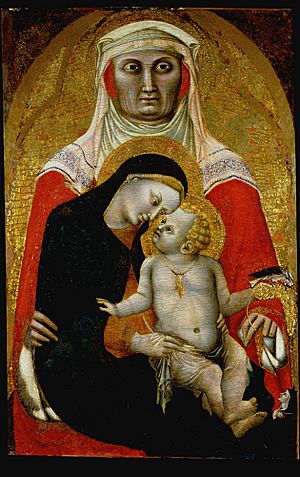Francesco Traini facts for kids
Francesco Traini was an Italian painter who lived and worked in the 1300s. He was active in cities like Pisa and Bologna from about 1321 to 1365.
He is thought to have been a follower of another artist named Andrea Orcagna. We know this from one of Traini's signed works: a large painting called a polyptych. He signed and dated this painting in 1345 for a church in Pisa. It shows Saint Dominic and scenes from the saint's life. This artwork is now in the Museo Nazionale in Pisa. Many experts also believe Traini painted some of the huge wall paintings, called frescoes, in the Camposanto Monumentale in Pisa. These include famous works like Last Judgement, Inferno, Legends of the Hermits, and the well-known Il Trionfo della Morte (The Triumph of Death).
You can find paintings by Traini in several art museums. These include the Princeton University Art Museum, the Ackland Art Museum, and the Carnegie Art Museum.
Contents
The Famous Triumph of Death Fresco
The Triumph of Death is a very famous and powerful wall painting. While some experts think another artist, Buonamico Buffalmacco, painted it, many others believe it was Francesco Traini.
What the Painting Shows
This large fresco shows how death affects everyone, no matter if they are rich or poor, young or old. It has different scenes that represent ideas like temptation, judgment, and suffering. The background also has symbolic parts: a rocky area for hermits (people who live alone for religious reasons) and a fertile area for earthly pleasures.
Its Original Meaning
For a long time, people thought this painting was created after the terrible sickness known as the Black Death in 1348. They believed it showed the horrors of that plague. However, some recent studies suggest the fresco was painted earlier, around 1333-1336. This means it wasn't a direct reaction to the Black Death.
Instead, the painting was on the outside wall of the town cemetery in Pisa. Its main purpose was to remind people that death is certain for everyone. It encouraged them to seek salvation through the church. The artwork reflects the ideas of the Dominican religious order, which designed it. It teaches people to turn away from worldly temptations and promotes a simple life. It also suggests that sinfulness causes suffering.
Damage Over Time
Sadly, many of the beautiful frescoes in the Camposanto, including parts of the Triumph of Death, were badly damaged or even destroyed during Allied air raids in World War II.
See also
 In Spanish: Francesco Traini para niños
In Spanish: Francesco Traini para niños



